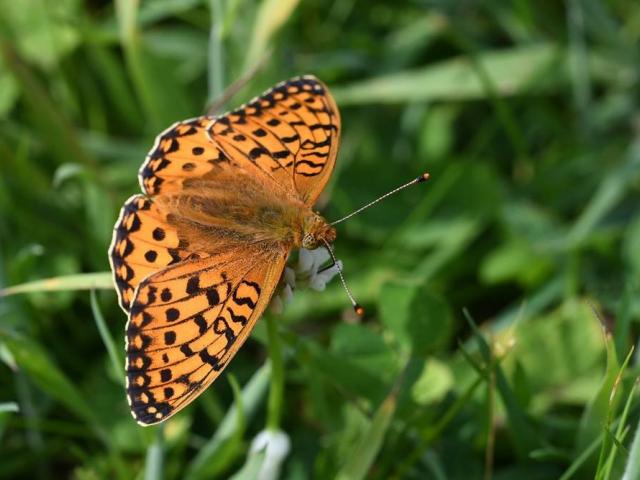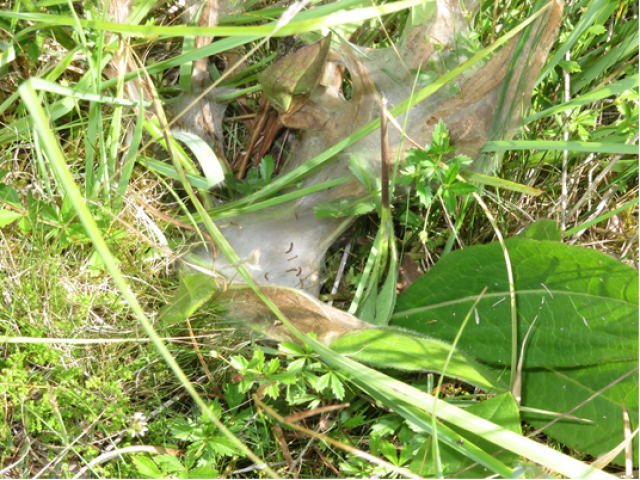From May to September in Wales around 90 volunteers report their sightings of Fritillary butterfly species.
They are all compiled into a newsletter, fondly known as ‘Frits About’ which is now in its 11th year. You can find it via the Butterfly Conservation Wales web pages.
Frits About reports on sightings of all six of the Fritillary species in Wales: Pearl-bordered, Small Pearl-bordered, Marsh, High Brown, Dark Green, and Silver-washed. This year has been exciting and fascinating, with the ‘Beast from the East’ followed by the very warm summer possibly affecting the different Fritillary species in different ways.
The Frits About story unfolds in stages with each edition. Here are some highlights from the summer of 2018 and a flavour of the contributions:
Frits About 13th June:
After nearly 45cm of snow in early March and a season about two weeks behind until late May, Small Pearl-bordered Fritillaries were seen in record numbers in the Alun Valley (near Bridgend) although the Pearl-bordered Fritillary across Wales only “did OK”.

David M: ‘Yesterday (10th June) saw my first Dark Green Fritillaries of the year, at Crymlyn Burrows on the coast. Around six pristine males were seen cavorting around the lush grassland, nectaring voraciously as if their lives depended on it....which I suppose is the truth!
The Marsh Fritillary has been seen in record numbers – totalling 1,056. In one north Carmarthenshire area over 700 were seen in one day.
Frits About 18th July: Summer sizzles on and some Frit species seem to have benefitted more than others.

Still doing well are Marsh Fritillaries in Carmarthenshire and in North Wales. Highlights included a timed count of 554 Marsh Frits in 90 minutes' walk across 8 fields in mid Carmarthenshire in June. Marsh Fritillary are surveyed by counting larval webs, usually seen in August and September.
This year there have been some unusually early sightings (3rd & 5th July) albeit small and with tiny caterpillars. Probably the lack of rain has helped them develop more visibly.
Small Pearl-bordered Fritillaries in the Alun Valley on dry, dog violet grassland have hit record numbers. In Carmarthenshire Richard & Kath P reported “Maybe 20++ on the Carmarthenshire/Ceredigion border, flying over wet fen/grassland with frequent Viola palustris”.
Doing less well were High Brown Fritillary at their remaining Welsh stronghold in Alun valley, where sightings between 11th June and 13th July were down on 2017. Dark Green Fritillary in the Alun Valley on the other hand seems to have done OK, although numbers may be disappointing compared to previous years when you consider 2018’s fine weather.
Frits About 22nd August:
The heatwave has subsided but the pattern noticed earlier in July continues.
7th August: the Pembrokeshire County Recorder advises “Report just received of another 2nd brood of Small Pearl-bordered on the coast path between Newgale & Solva where first brood are reported every year”.
8th August: Amanda E advises that the survey at a site managed by the Caeau Mynydd Mawr project, near Cross Hands revealed 86 Marsh Fritillary larval webs! At Rhos Cefn Bryn, Wildlife Trust volunteers and staff found 27 larval webs. In a field near Cwmgors, which usually only supports between 1 and 20 webs, a massive total of 189 webs were found.
Highlights and concerns of 2018
Richard Smith, who painstakingly compiles Frits About, concludes:
Doing this year well are Small Pearl-bordered Fritillary, which had a good first brood and a partial second brood, and Silver-washed Fritillary which seems to have emerged earlier than normal, with good numbers spreading out from traditional sites.
Marsh Fritillaries - whose caterpillars specialise in feeding only on Devil’s-bit Scabious in marshy grassland - have had an exceptional year in South Wales, especially in Carmarthenshire. By October they had been found in a total of 71 Carmarthenshire fields where they had not been seen for at least 25 years. Twenty six of the new fields are in the wider Mynydd Mawr area which surrounds Butterfly Conservation’s Caeau Ffos Fach / Median Farm Reserve at Cross Hands. This puts Carmarthenshire firmly into Marsh Fritillary ‘stronghold’ status amongst Welsh counties with 106 one km OS grid squares occupied since 2005. Glamorgan follows next with 71 occupied one km squares.
Perhaps three fritillary species in Wales have benefitted less from our exceptional summer. High Brown Fritillary numbers were down by almost 40% on last year at its one remaining locality in Wales. This is of obvious concern and we will be reviewing possible factors. Also Pearl-bordered Fritillary sightings have been fairly average and variable although in Ewyas Harold (just over the English border) it did well. Dark Green Fritillary numbers seem to have been down overall although its range still appears to be as widespread.


